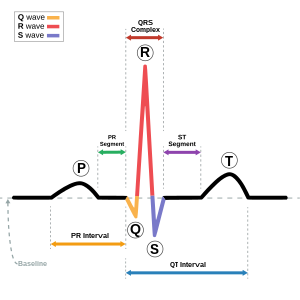
Back نظم جيبي Arabic Ritme sinusal Catalan Sinusrytme Danish Sinusrhythmus German Ritmo sinusal Spanish ضرباهنگ کاوکی Persian Rythme sinusal French Ritmo cardiaco Italian 굴리듬 Korean Rytm zatokowy Polish

A sinus rhythm is any cardiac rhythm in which depolarisation of the cardiac muscle begins at the sinus node.[1] It is necessary, but not sufficient, for normal electrical activity within the heart.[2] On the electrocardiogram (ECG), a sinus rhythm is characterised by the presence of P waves that are normal in morphology.[2]
The term normal sinus rhythm (NSR) is sometimes used to denote a specific type of sinus rhythm where all other measurements on the ECG also fall within designated normal limits, giving rise to the characteristic appearance of the ECG when the electrical conduction system of the heart is functioning normally; however, other sinus rhythms can be entirely normal in particular patient groups and clinical contexts, so the term is sometimes considered a misnomer and its use is sometimes discouraged.[3][4]

Other types of sinus rhythm that can be normal include sinus tachycardia, sinus bradycardia, and sinus arrhythmia. Sinus rhythms may be present together with various other cardiac arrhythmias on the same ECG.
- ^ Hampton, John R (2013). The ECG Made Easy (8th ed.). Edinburgh: Churchill Livingstone. p. 4. ISBN 9780702046421.
- ^ a b Cite error: The named reference
twostepwas invoked but never defined (see the help page). - ^ Conover, Boudreau Conover (2003). Understanding Electrocardiography (8th ed.). St Louis: Mosby. p. 46. ISBN 9780323019057.
- ^ Geiter, Henry B. (2006). E–Z ECG Rhythm Interpretation (1st ed.). Philadelphia: F.A. Davis. p. 106. ISBN 9780803620353.
© MMXXIII Rich X Search. We shall prevail. All rights reserved. Rich X Search